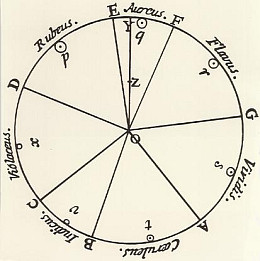Isaac Newton (1642–1727 CE) was an English mathematician, physicist, astronomer, and author who is widely recognized as one of the most influential scientists of all time. His work laid the foundation for classical mechanics and significantly advanced the understanding of light and color.
Born in Woolsthorpe, England, Newton made substantial contributions across various fields, but his work in optics and color theoryColor Theory is a comprehensive framework used to understand and analyze the use and interaction of colors in visual compositions. It serves as a critical guide for artists, designers, and marketers, helping them create harmonious and effective designs. This concept encompasses various principles and elements that dictate how colors are combined, perceived, and utilized. Primary Colors: • The three foundational More stands out as particularly groundbreaking.

- Key Contributions:
- Formulated the laws of motion and universal gravitation
- Developed a comprehensive theory of color
- Invented the reflecting telescope
Newton’s interest in optics led him to conduct experiments with prisms. He demonstrated that white light is composed of a spectrum of colors, which can be separated and recombined.
Optics and Color TheoryColor Theory is a comprehensive framework used to understand and analyze the use and interaction of colors in visual compositions. It serves as a critical guide for artists, designers, and marketers, helping them create harmonious and effective designs. This concept encompasses various principles and elements that dictate how colors are combined, perceived, and utilized. Primary Colors: • The three foundational More: Newton’s experiments with light and prisms revealed that white light could be split into its component colors—red, orange, yellow, green, blue, indigo, and violet. He showed that these colors are inherent properties of light, not products of the prism or other materials.
- White Light Composition:
- White light consists of various colors
- Colors can be separated by a prism
- Recombining colors can recreate white light
His findings disproved the prevailing belief that colors were modifications of white light through interaction with objects. Newton’s work established that colors are intrinsic to light itself.
Color Wheel: To visualize the relationships between colors, Newton arranged the spectrum in a circular format, creating the first color wheel. This tool helped explain how colors blend and contrast, influencing both scientific and artistic communities.

- Color Relationships:
- Spectrum arranged in a circular color wheel
- Shows primary and secondary color relationships
- Helps understand color mixing and harmony
Optical Observations: Newton’s work extended to studying how light interacts with surfaces and mediums. He explored reflection, refraction, and the phenomenon of diffraction. His theories on light and color were detailed in his book “Opticks,” published in 1704.
- Light Interaction:
- Studied reflection and refraction
- Explored diffraction of light
- Documented findings in “Opticks”
“Opticks” provided a comprehensive look at Newton’s experiments and theories, influencing subsequent generations of scientists and artists.
Scientific Method: Newton’s approach to scientific inquiry involved meticulous experimentation and mathematical analysis. He believed in verifying hypotheses through reproducible experiments, setting a standard for future scientific research.
- Methodology:
- Emphasized empirical evidence
- Conducted reproducible experiments
- Applied mathematical rigor to observations
His methods underscored the importance of combining theoretical insights with practical experimentation, a hallmark of the scientific revolution.
Influence and Legacy: Newton’s discoveries in optics and color theoryColor Theory is a comprehensive framework used to understand and analyze the use and interaction of colors in visual compositions. It serves as a critical guide for artists, designers, and marketers, helping them create harmonious and effective designs. This concept encompasses various principles and elements that dictate how colors are combined, perceived, and utilized. Primary Colors: • The three foundational More had a profound impact on science and art. His work laid the groundwork for future studies in these fields and remains integral to our understanding of light and color.
- Impact:
- Influenced the development of modern physics and optics
- Provided tools and concepts for artists and scientists
- His color theoryColor Theory is a comprehensive framework used to understand and analyze the use and interaction of colors in visual compositions. It serves as a critical guide for artists, designers, and marketers, helping them create harmonious and effective designs. This concept encompasses various principles and elements that dictate how colors are combined, perceived, and utilized. Primary Colors: • The three foundational More remains a foundational aspect of art education
Isaac Newton’s contributions to color theoryColor Theory is a comprehensive framework used to understand and analyze the use and interaction of colors in visual compositions. It serves as a critical guide for artists, designers, and marketers, helping them create harmonious and effective designs. This concept encompasses various principles and elements that dictate how colors are combined, perceived, and utilized. Primary Colors: • The three foundational More, encapsulated in his prism experiments and the creation of the color wheel, continue to shape our understanding of light and color. His blend of empirical research and theoretical innovation set new standards for scientific inquiry.
